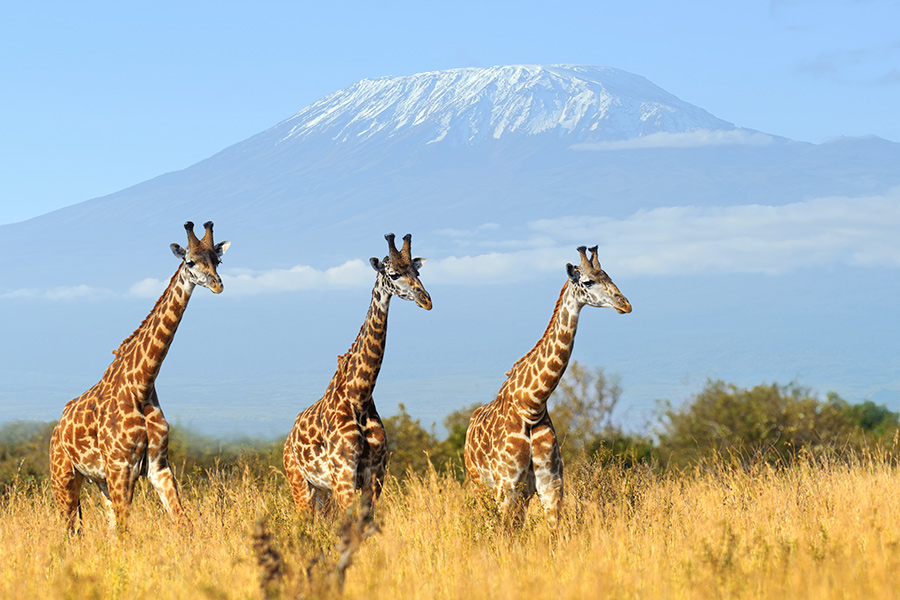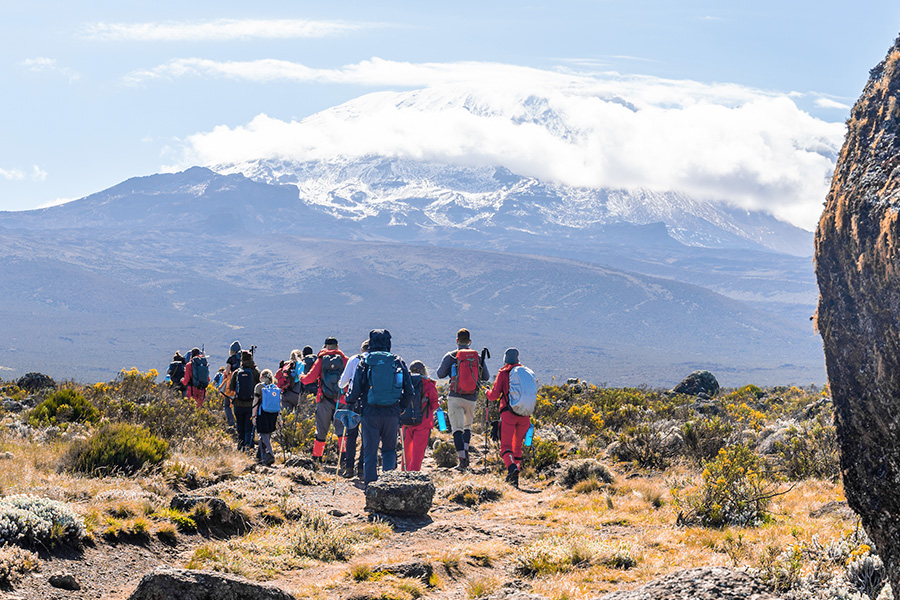Awe-inspiring views, diverse landscapes, and abundant wildlife await
Trekking snow-capped Mount Kilimanjaro in northern Tanzania is truly a once-in-a-lifetime experience. Forged by the prehistoric fusion of ash, lava, and rock, this geological masterpiece is Africa’s highest peak, earning its place as a UNESCO World Heritage Site, and one of the most magnificent sights on the continent. Prepare to be spellbound as you step into a realm where sublime hiking unveils hidden sanctuaries and vistas that stir the soul.
Ascending Kilimanjaro begins at its lush, tropical base; a gradual climb finally reveals its icy pinnacle. Experience a guided journey that traverses verdant rainforest, rugged alpine desert, and secluded glaciers. Immerse yourself in the lower slopes where crystalline waterfalls cascade through woodlands, while elusive black and white colobus monkeys dart through dense canopies. For the more adventurous, the lesser-known Northern Circuit, on the mountain’s more remote northern slopes, rewards hikers with the beautiful quiet of undisturbed rainforest, ancient, lichen-draped volcanic rock, and the gentle fragrance of wildflowers underfoot.
Along with the exhilaration of trekking, luxury safaris — with the opportunity to see the Big Five — can be experienced in the area, most notably in the Serengeti National Park and the Ngorongoro Conservation Area.
Bask in opulence at lavish tented lodges and indulge in glamorous, high-altitude camping encounters. Here, witness nature’s grandeur unfold below: an extraordinarily beautiful volcanic caldera, and giraffe silhouettes shimmering against a setting African sun.
Kilimanjaro is a popular destination for hikers and nature enthusiasts alike, but it also offers unique cultural experiences. Enveloped in a history of human habitation, a local tribe, the Chagga, consider the mountain a place of spiritual significance and hidden, ancestral shrines can be found in high forested areas. Embark on a guided journey into their world, where traditions unfurl and stories intertwine, providing a profound glimpse into the heart of a mountain they’ve cherished across the ages.
What is the region known for?
Mount Kilimanjaro stands as the African continent’s towering pinnacle, celebrated for its breathtaking snow-capped summit and the exhilarating ascent it offers to adventurers. Whether you’re a novice or an experienced hiker, guided climbs are available, catering to various skill levels, from gentle introductory treks to the demanding journey to the peak. Immerse yourself in the remarkable landscapes of the Kilimanjaro Game Reserve, unveiling a world of natural beauty waiting to be explored.

Wildlife: Safari Experience
The nearby Serengeti National Park and Ngorongoro Conservation Area are filled with thrilling safari and wildlife tours, presenting the opportunity to witness the famed “Big Five.” However, should you miss encountering these magnificent creatures, a wide range of alternative activities awaits you. You can embark on hikes along the numerous trails that meander through Kilimanjaro’s lower slopes, immerse yourself in the enchanting beauty of the surrounding forests and discover hidden waterfalls, all while encountering the diverse and unique flora and fauna that grace this extraordinary region.

Luxury Accommodation: Exclusive Retreats
Travelers drawn to Kilimanjaro are primarily motivated by two pursuits: scaling the majestic mountain and embarking on a captivating safari adventure. A common itinerary involves commencing their journey with the ascent of Mount Kilimanjaro and culminating with a safari expedition in the Serengeti National Park or the Ngorongoro Crater. Accommodation options in the region typically lean towards comfort rather than opulence, encompassing a range of choices such as tented camps, lodges situated in proximity to the mountain and nearby towns, as well as mid-level luxury hotels.

Scenic Beauty: Pristine Landscapes
Located in northern Tanzania, Mount Kilimanjaro showcases an array of landscapes, encompassing everything from alpine deserts to glaciers and lush rainforests. The terrain’s characteristics also fluctuate with the changing seasons. The most favorable time for ascending the mountain is during the dry seasons, spanning from December to March and then from July to September.

Adventure Activities: Thrilling Excursions
While ascending Mount Kilimanjaro often stands as the main attraction for visitors to the region, there are various approaches to this remarkable journey. Some adventurers, driven by a thirst for excitement, opt for the challenging Umbwe route, renowned for its steep ascent and heightened risk due to limited acclimatization opportunities. Alternatively, there are milder routes that allow hikers to fully savor the awe-inspiring landscapes that surround them.

Exclusive Sightseeing Tours
Discover unique cultural experiences that immerse you in the world of the Chagga people, an ancient tribe with a deep-rooted history on the Kilimanjaro slopes, renowned as the most prosperous in the area. Additionally, organized safaris are available to showcase the region’s captivating natural beauty, featuring its rich and diverse wildlife and flora.
Frequently Asked Questions
When is the best time to visit Kilimanjaro?
Kilimanjaro offers accessibility for visits and mountain climbing throughout the year. However, the most favorable period is during the dry season when the summit routes are at their safest and you can see the sands of Kilimanjaro. It’s advisable to plan your adventure between December and March, or from July to September.
What wildlife can be seen in Kilimanjaro?
Kilimanjaro stands out as one of the rare locations in Africa where you can encounter the complete array of the Big Five: elephants, leopards, lions, black rhinos, and buffalo. The region is also home to numerous other species, such as primates and a diverse range of bird species making a Kilimanjaro safari tour a truly unique experience for travelers.
How was Kilimanjaro formed and what makes it so difficult to climb?
Mount Kilimanjaro originated as a volcano, now in a dormant state. This volcanic activity resulted in the formation of three distinct cones: Kibo, Mawenzi, and Shira. The highest point is located on Kibo, while Mawenzi ranks as Africa’s third-highest peak. Shira, once a peak itself, lost its status due to a collapse and gave rise to the Shira Plateau. Two established routes, Machame and Lemosho, traverse this plateau.
Kilimanjaro’s reputation as a challenging climb is partly attributed to the risk of altitude sickness. This risk can be underestimated because the mountain is accessible to a wide range of climbers, including those with disabilities. Adequate preparation for altitude sickness is crucial when conditioning yourself for the ascent.
What kind of terrain can be expected in Kilimanjaro?
Kilimanjaro boasts a range of distinctive microclimates or zones that shift as you ascend. Your journey will take you through semi-arid scrubland, dense forests, expansive moorlands, an alpine desert, and the luxuriant landscapes of the southern slopes. These diverse zones are traversed by the various routes, each offering a unique blend of these environments.
For those whose Kilimanjaro aspirations don’t necessarily include reaching the summit, many opt to trek up to the forest belt encircling the mountain. This provides breathtaking vistas and carries virtually no risk of altitude sickness.
What are some activities and attractions in Kilimanjaro?
The Kilimanjaro region offers a multitude of attractions that don’t require extensive hikes. You can explore the Materuni Waterfalls and pay a visit to the Uhuru Museum. Additionally, a wide array of exclusive tours awaits, such as coffee and tea tours, culinary adventures to savor local cuisine, exhilarating hot air balloon rides, leisurely bicycle tours, and off-road excursions tailored for 4×4 enthusiasts.
Unlock a world of life-changing adventures
Subscribe to receive new product information, special offers, and first-priority privileges to our scheduled journeys










